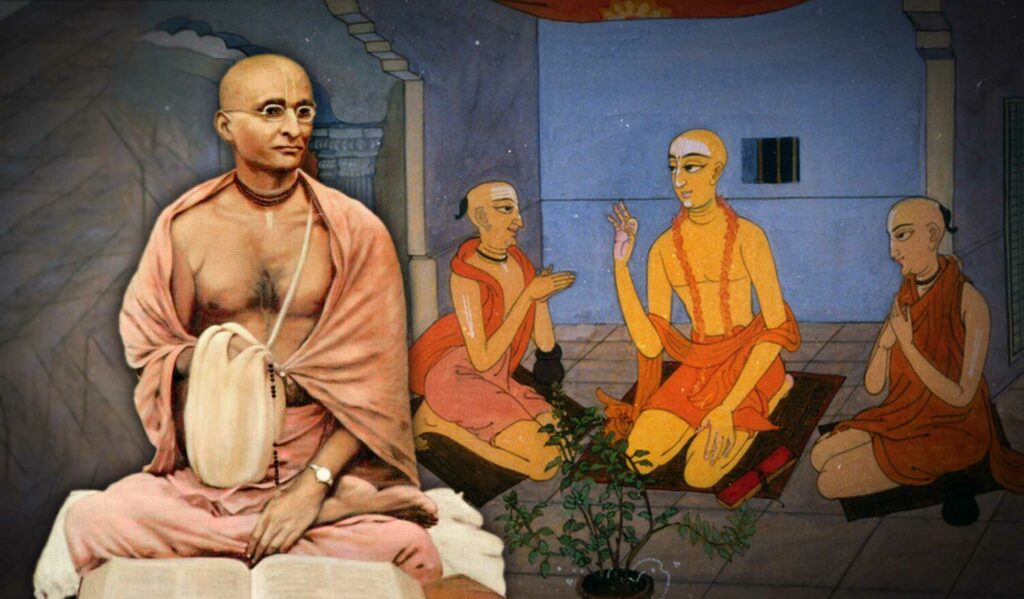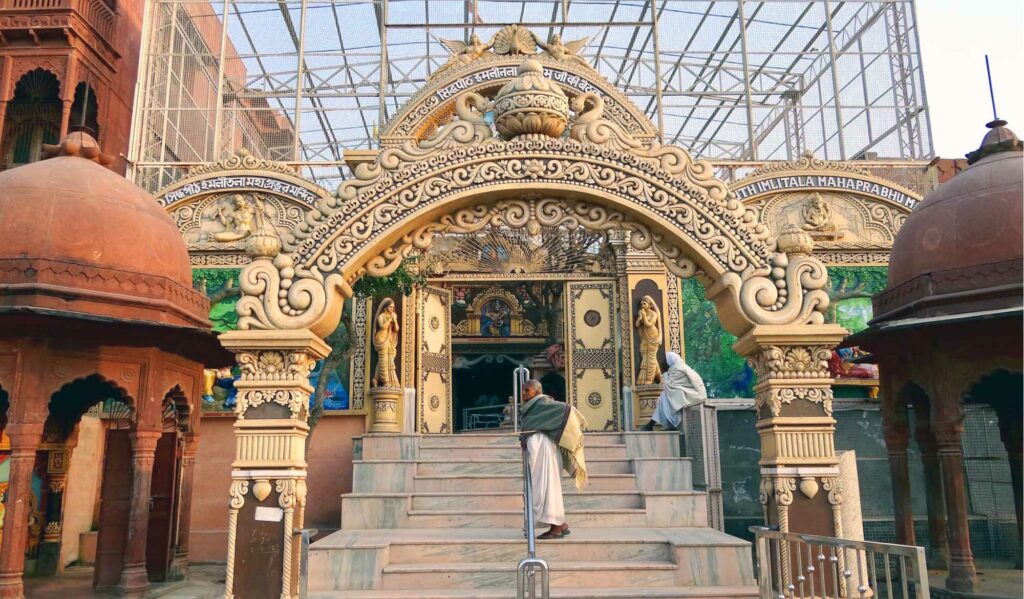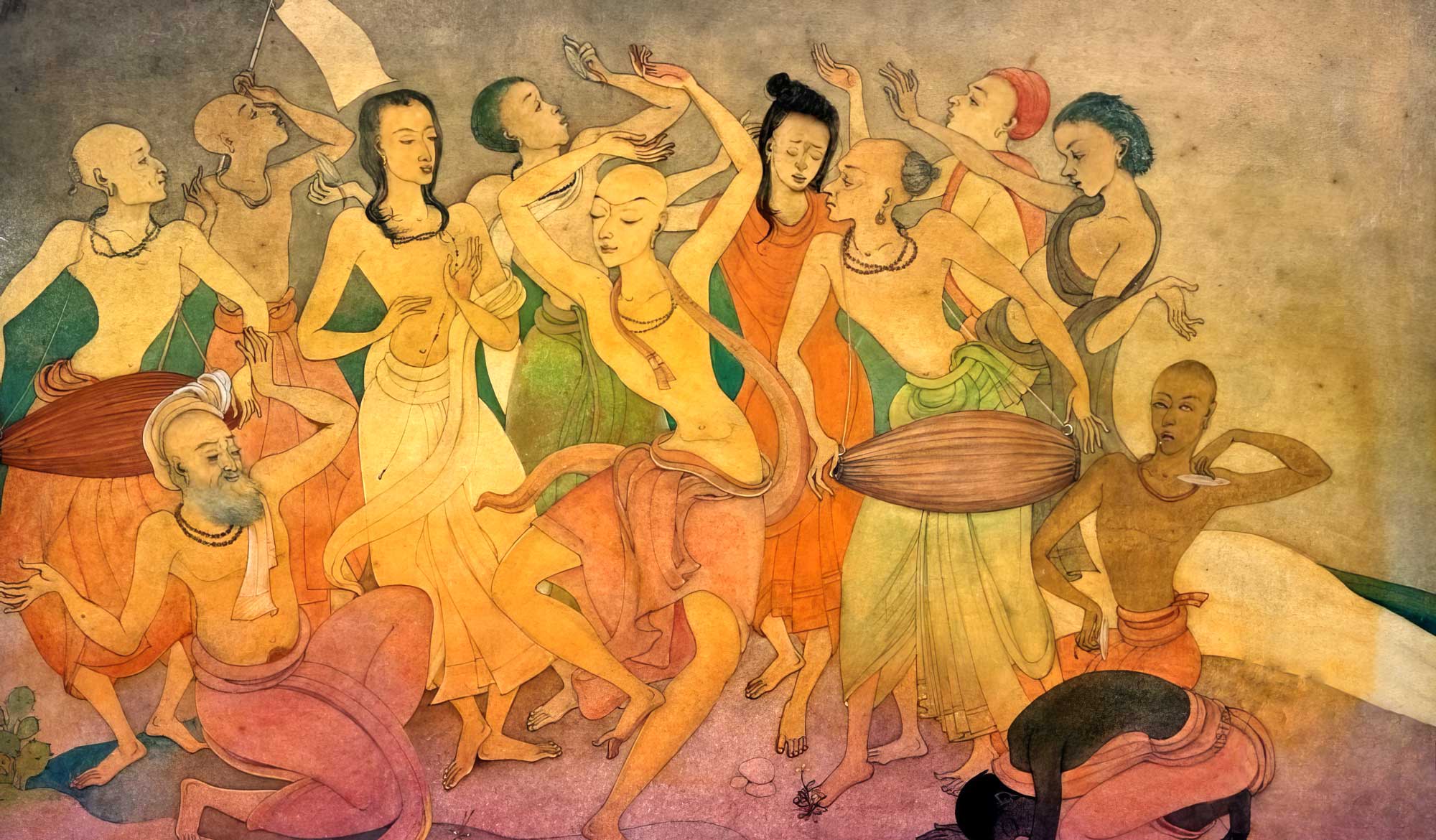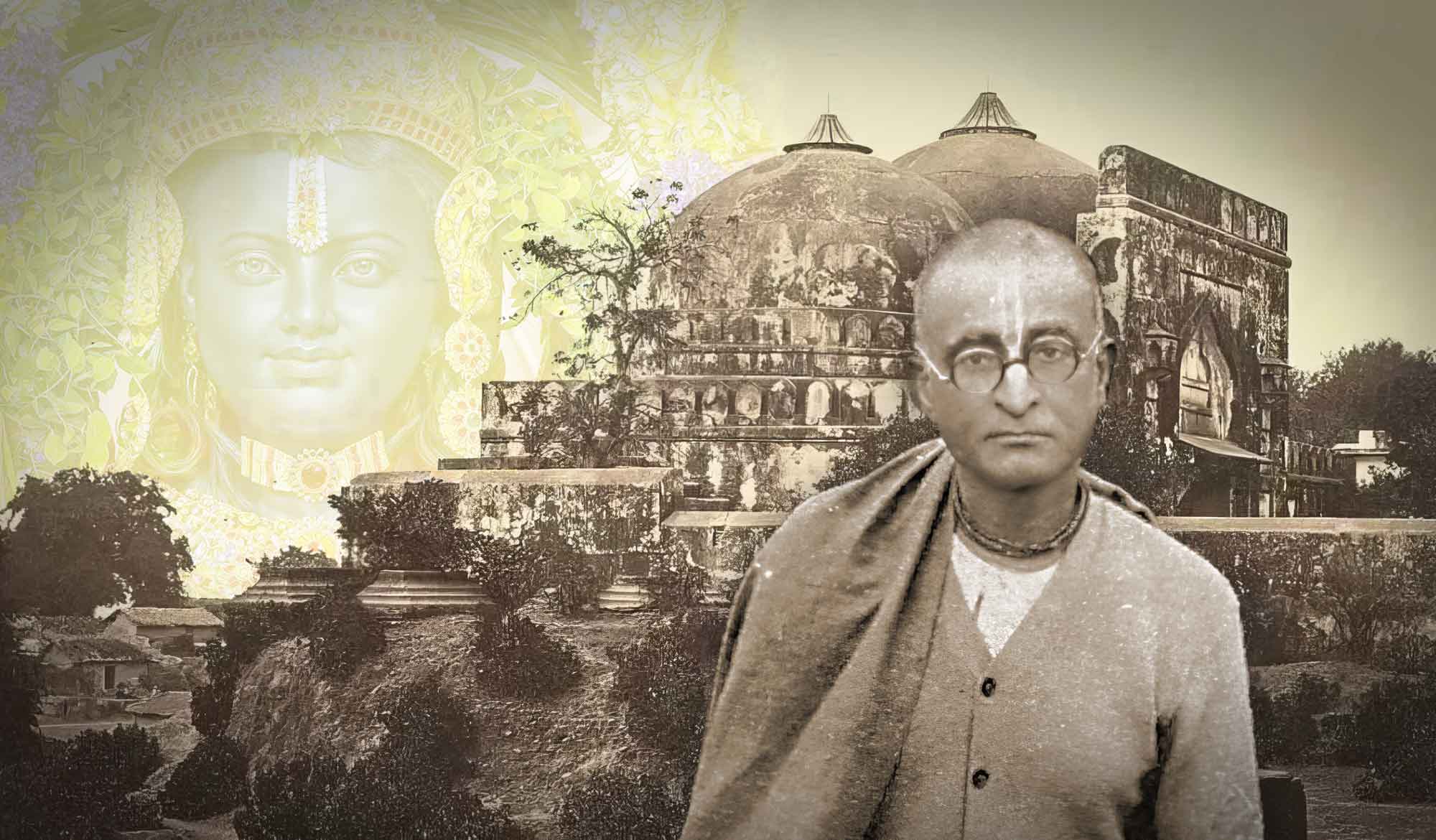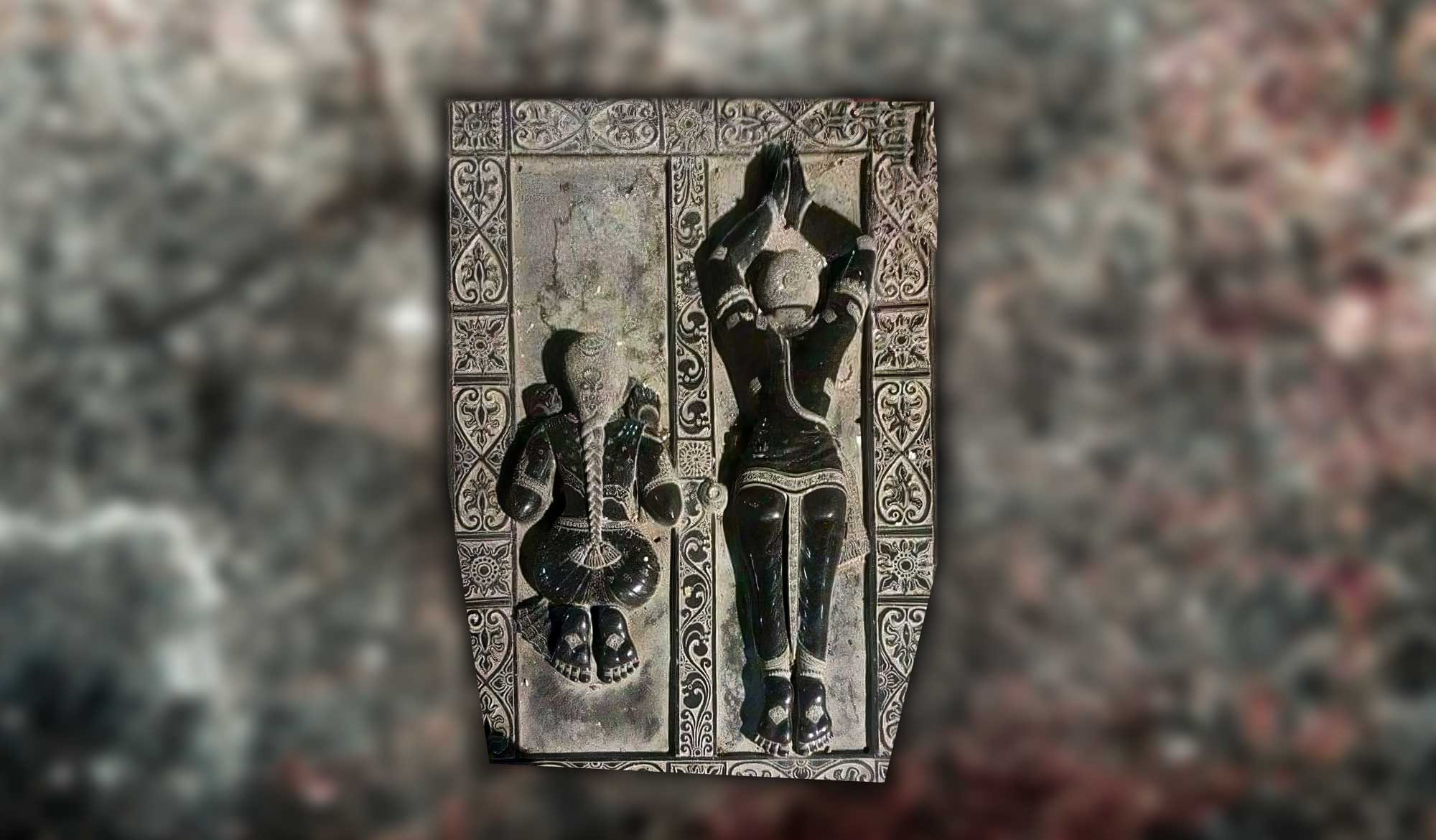Overview
The following article is based upon a talk by Śrīla B.G. Narasiṅgha Mahārāja given in 1998. Mahārāja discusses Śrīla Prabhupāda’s position as a śaktyāveśa-avatāra (empowered incarnation) of Nityānanda Prabhu and connects this to his withdrawal from this mortal world in 1977.
A week or so after the disappearance of Śrīla A.C. Bhaktivedānta Swami Prabhupāda, there was a virāha-mahotsava (memorial service) at the Candrodaya Mandira in Māyāpura where many members of the Gauḍīya Maṭha came and spoke about his life and achievements. One of Prabhupāda’s godbrothers named Śrīla Bhakti Vicāra Yāyavāra Mahārāja gave a talk to all the devotees and said that Śrīla Prabhupāda was a śaktyāveśa-avatāra. This was not a new word to us. We had already heard and read about śaktyāveśa-avatāras in the Śrīmad Bhāgavatam – empowered devotees who are delegated for a specific mission. Yāyavāra Mahārāja said that in his estimation our Śrīla Prabhupāda was empowered by Lord Kṛṣṇa to spread this Kṛṣṇa consciousness movement all over the world and therefore he said he was a śaktyāveśa-avatāra.
You may encourage someone to chant the Holy Name or you might get your children to chant. Many devotees are doing that and of course, that takes some kind of empowerment. However, just getting a few people to chant Hare Kṛṣṇa doesn’t make you a śaktyāveśa-avatāra. But one who can enthuse a whole planet and take the Holy Name of Kṛṣṇa anywhere and everywhere is something very different. Śrīla Prabhupāda had unwavering faith in the Holy Name (nāma-śraddhā), and his vision was that, regardless of how or where, the more the Holy Name of Kṛṣṇa was vibrated, the more benefit would come to the world in the form of God consciousness.
Some years later, devotees went to visit Prabhupāda’s beloved godbrother Śrīla B.R. Śrīdhara Mahārāja who was living in Navadvīpa and they told him that Yāyavāra Mahārāja had said that Prabhupāda was a śaktyāveśa-avatāra. During their discussion with Śrīla Śrīdhara Mahārāja, he said, “Yes, it must be so because what he has done is humanly impossible. No one can spread the Holy Name of Kṛṣṇa so widely without directly being empowered by Kṛṣṇa. This is the opinion of the śāstra” Then he explained that in particular, Śrīla Prabhupāda was the śakti of Nityānanda Prabhu.
Kṛṣṇa expands as Balarāma, but Balarāma does not expand as Nityānanda – He is Nityānanda. There is a difference. Nityānanda is not an expansion but is directly Lord Balarāma. There are many things under the jurisdiction of Balarāma. For example, He is in charge of the accommodating space for existence. Every object occupies space and as Ananta, Balarāma provides the space in which all things exist. In the spiritual world, Kṛṣṇa’s pastimes are arranged by Yogamāyā who is the direct potency of Balarāma, Whenever the pastimes of Kṛṣṇa are to be expanded in a particular līlā, it is Yogamāyā who makes all the arrangements for that expansion. Śrīla Śrīdhara Mahārāja then explained that when the saṅkīrtana of the Holy Name of Kṛṣṇa expands in this material world, that is the work of Nityānanda Prabhu. It is His potency which enables this to happen.
Śrīla Śrīdhara Mahārāja further explained how Nityānanda Prabhu was sent to Bengal to spread the Holy Name. Actually, the main saṅkīrtana leader in this world is Nityānanda Prabhu. There are many stories how He used to go out on saṅkīrtana and would drag Haridāsa Ṭhākura with Him. Haridāsa Ṭhākura was a very timid, gentle Vaiṣṇava and so his mood was a little withdrawn. But Nityānanda Prabhu would drag him hither and thither, sometimes right into people’s living rooms. He was very, very bold. When Nityānanda Prabhu entered someone’s house, the first thing He did was smash up all their furniture, and finally He would lie down on the ground, pounding His fists on the floor. He would create such a ruckus that by the time He had finished, the whole family would just be standing there with their mouths open in shock. When they were all like that, Nityānanda would tell them, “You please chant gaurāṅga-nāma!” Then He would leave and go to the next house. He had a unique preaching style.
Whenever the pastimes of Kṛṣṇa are to be expanded, including the pastimes of spreading the Holy Name, this is the charge of Śrī Nityānanda Prabhu. Therefore, Śrīla Śrīdhara Mahārāja said that Prabhupāda was especially empowered by Nityānanda Prabhu to do this work. Otherwise it was not humanly possible. It is not possible for an ordinary devotee to simply go out and conduct such an extensive preaching campaign that in twelve years devotees could go to places which had never heard even a remote semblance of the Name of Kṛṣṇa and establish Kṛṣṇa consciousness there. This can only be done by divine arrangement. Therefore, Śrīla Śrīdhara Mahārāja agreed with Yājavāra Mahārāja that Śrīla Prabhupāda was a śaktyāveśa-avatāra of Śrī Nityānanda Prabhu, and he added “In my opinion, Nityānanda Prabhu personally lived in the body of Swami Mahārāja for twelve years.”
I have told devotees many times that Śrīla Prabhupāda’s passing from this world was not like some ordinary person who just grows old and after some time simply dies. It wasn’t like that at all. In fact, Prabhupāda had no known disease. There was nothing physically wrong with him. Yet if we follow the line of thought of Śrīla Śrīdhara Mahārāja that Nityānanda Prabhu entered Prabhupāda’s body for twelve years, it means that at a particular time Nityānanda Prabhu came and at a particular time He withdrew. And when Nityānanda withdrew, then at that same time Śrīla Prabhupāda also began to withdraw from this world.
In February of 1977, Śrīla Prabhupāda came to Navadvīpa and visited Śrīla Śrīdhara Mahārāja and told him, “I do not know for how long I will be able to carry on.” It was a short part of their conversation, but he requested Śrīla Śrīdhara Mahārāja to come and stay with him in Māyāpura and help him train his disciples. After that, Śrīla Prabhupāda started withdrawing. During that time in Māyāpura, he came down to give the class, sat on the vyāsāsana, and a particular mood appeared within him. Generally, he would always sing Jaya Rādhā-Mādhava, but on this occasion he requested others to sing it. Finally, someone else sang and he sat there with his eyes closed. Then after the song was over, there was a long pause and he just got up and went to his room. There was no class. Then for the next nine months or so, there were his pastimes of departure from this world.
On Śrīla Prabhupāda’s disappearance day, we hear many devotees talk about his final pastimes and they always describe how thin and emaciated he became, how he didn’t eat etc. But the phrase ‘separation from Kṛṣṇa’ never appears in their talks. What they describe as his ‘sickness’ was not sickness. They never relate his physical condition to separation. When Nityānanda Prabhu withdrew, then due to great attachment and separation from the Supreme Lord, Śrīla Prabhupāda also withdrew from this world.
I have read descriptions of Gadādhara Paṇḍita after Śrī Caitanya Mahābrabhu disappeared. Previously, Mahāprabhu had told him to remain for some years and wait for Śrīnivāsa Ācārya, “You wait for Śrīnivāsa, and when he comes you should teach him the Bhāgavatam. After that, you can leave the world and rejoin Me in Goloka.” By the time Śrīnivāsa Ācārya arrived in Purī, some years had gone by and Gadādhara Paṇḍita was feeling intense separation from Mahāprabhu. The descriptions of Gadādhara at that time are almost the same physical symptoms that were visible in Śrīla Prabhupāda. All these were due to Gadādhara Paṇḍita’s intense feelings of separation from Śrī Caitanya Mahāprabhu. So Śrīla Prabhupāda manifested similar symptoms of separation. Some may think this is all speculation, but how can it be so? If we see the outstanding achievements and characteristics of Śrīla Prabhupāda, how can we think otherwise?
We may also experience a similar small, minute fraction of that feeling of separation when our guru leaves this world. On that fateful day, for a disciple, it seems like the sun has totally vanished. But all things are perfect by Kṛṣṇa’s arrangement. For example, when children are at play, they see each other face to face, but then one child runs and hides, the others have to search him out, and they may search for him very intensely. Similarly, separation from Śrī Guru increases our attachment to him. To help us come to the point of perfection, in most cases it is necessary to experience separation from Śrī Guru. Eventually he will vanish from this world and be gone from our formal sight. Then we must try and find him on a more subtle plane – the plane of our consciousness. Hare Krsna!
Related Articles
- 📖 Prabhupāda Vijaya (Book)
- My Guru is Rādhārāṇī by Śrīla Bhakti Gaurava Narasiṅgha Mahārāja
- Become Guru! by Śrīla Bhakti Gaurava Narasiṅgha Mahārāja
- Purport to Śrīla Prabhupāda-līlā Smaraṇa-Maṅgala Stotram by Śrīla Bhakti Gaurava Narasiṅgha Mahārāja
- Mahāprabhu as Prabhupāda by Śrīla Bhakti Gaurava Narasiṅgha Mahārāja
- How Great is Śrīla Prabhupāda? by Śrīla Bhakti Gaurava Narasiṅgha Mahārāja
- A Few Words on the Rasa of Śrīla Prabhupāda and the ‘Suicide Squad’ by Śrīla Bhakti Gaurava Narasiṅgha Mahārāja
- The Prākṛta and Aprākṛta-līlā of Śrī Guru by Śrīla Bhakti Gaurava Narasiṅgha Mahārāja
- The Golden Age of the Saṅkīrtana Movement by Śrīla Bhakti Gaurava Narasiṅgha Mahārāja
- Bhaktivedānta by Śrīla Bhakti Gaurava Narasiṅgha Mahārāja
- The Disappearance of a Śaktyāveśa-avatāra by Śrīla Bhakti Gaurava Narasiṅgha Mahārāja
- Śrīla Prabhupāda – A Second Generation Devotee’s Perspective by Gaura Gopāla Dāsa
Pilgrimage with Swami Narasiṅgha – Part 7: Keśī Ghāṭa
Continuing with our pilgrimage series, this week Śrīla Narasiṅgha Mahārāja takes us to Keśī Ghāṭā where he tells us about Madhumaṅgala’s meeting with the Keśī demon, what Keśī represents, and how Śrīla Prabhupāda almost acquired Keśī Ghāṭa. Mahārāja also narrates his own experience. This article has been adapted from a number of talks and articles by Narasiṅgha Mahārāja.
Prema Dhāma Deva Stotram with the Narasiṅgha Sevaka Commentary – Verses 61-65
In verses 61 to 65 of 'Prema Dhāma Deva Stotram', Śrīla Śrīdhara Mahārāja narrates the pastime of Śrī Caitanya at Caṭaka Parvata In Purī and explains how the scriptures produced by Brahmā and Śiva are ultimately searching for the personality of Mahāprabhu who is merciful too all jīvas, no matter what their social position.
Prabhupāda Śrīla Sarasvatī Ṭhākura’s Visit to Ayodhyā
With the forthcoming observance of Śrī Rāma Navamī, we present 'Prabhupāda Śrīla Sarasvatī Ṭhākura’s Visit to Ayodhyā' written by Śrīla Bhaktisiddhānta Sarasvatī Ṭhākura Prabhupāda from The Gaudīyā magazine, Vol 3. Issue 21/ In December 1924, after visiting Benares and Prāyāga, Sarasvatī Ṭhākura visited the birth-site of Śrī Rāmācandra in Ayodhyā.
Śaraṇāgati – The Only Path to Auspiciousness
In this article, 'Śaraṇāgati - The Only Path to Auspiciousness', Dhīra Lalitā Dāsī analyses the process of śaraṇāgati (surrender) beginning with śraddhā (faith). She also discusses the role of śāstra and the Vaiṣṇava in connection with surrender.
Pilgrimage with Swami Narasiṅgha – Part 7: Keśī Ghāṭa
Continuing with our pilgrimage series, this week Śrīla Narasiṅgha Mahārāja takes us to Keśī Ghāṭā where he tells us about Madhumaṅgala’s meeting with the Keśī demon, what Keśī represents, and how Śrīla Prabhupāda almost acquired Keśī Ghāṭa. Mahārāja also narrates his own experience. This article has been adapted from a number of talks and articles by Narasiṅgha Mahārāja.
Prema Dhāma Deva Stotram with the Narasiṅgha Sevaka Commentary – Verses 61-65
In verses 61 to 65 of 'Prema Dhāma Deva Stotram', Śrīla Śrīdhara Mahārāja narrates the pastime of Śrī Caitanya at Caṭaka Parvata In Purī and explains how the scriptures produced by Brahmā and Śiva are ultimately searching for the personality of Mahāprabhu who is merciful too all jīvas, no matter what their social position.
Prabhupāda Śrīla Sarasvatī Ṭhākura’s Visit to Ayodhyā
With the forthcoming observance of Śrī Rāma Navamī, we present 'Prabhupāda Śrīla Sarasvatī Ṭhākura’s Visit to Ayodhyā' written by Śrīla Bhaktisiddhānta Sarasvatī Ṭhākura Prabhupāda from The Gaudīyā magazine, Vol 3. Issue 21/ In December 1924, after visiting Benares and Prāyāga, Sarasvatī Ṭhākura visited the birth-site of Śrī Rāmācandra in Ayodhyā.
Śaraṇāgati – The Only Path to Auspiciousness
In this article, 'Śaraṇāgati - The Only Path to Auspiciousness', Dhīra Lalitā Dāsī analyses the process of śaraṇāgati (surrender) beginning with śraddhā (faith). She also discusses the role of śāstra and the Vaiṣṇava in connection with surrender.


